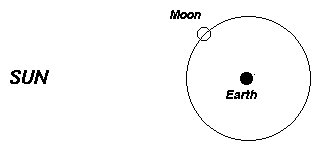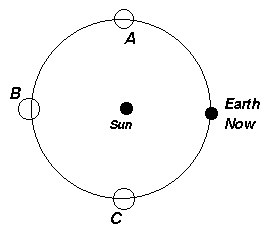ASTR 1210 (O'Connell)
SAMPLE EXAM QUESTIONS
This selection of questions from old exams is intended to show you the
style and difficulty of questions which are typical of my exams. It is
NOT intended to emphasize the most important topics to be covered on
the exam. For that, see the exam "Hints". Correct answers to these questions are available.
In which direction does the Sun appear to move from one day to the
next with respect to the stars? A) north; B) south; C) east; D)
west.
A healthy, fruit-based model of the nearby stars in which the Sun was
the size of an orange would have to be how large in size just to
contain the next nearest star? A) 100 feet; B) 100 yards; C) 1 mile;
D) 10 miles E) thousands of miles.
(T/F) A particular constellation rises at the same time every night.
An alien visitor from a planet with a slow rotation period
becomes nostalgic for long nights. Where on the Earth's surface would
you recommend that she goes? A) to the poles; B) to the equator; C)
to Las Vegas; D) sorry: all places on Earth have days with equal
lengths.

This sketch shows the Sun, Earth, and the Moon at a particular point
in its orbit. In what "phase" will the Moon be at this time as viewed
from Earth? A) Full; B) First quarter; C) Crescent; D) New.
The retrograde motion of Mars can best be explained as: A) Mars
reversing its motion in its orbit; B) the Earth reversing its motion
in its orbit; C) the Earth overtaking and passing Mars; D) the stars
reversing their motion.
The "obliquity of the ecliptic" is defined to be the angle between the
Earth's rotation axis and a direction perpendicular to the plane of
the ecliptic. This angle is presently 23.5 degrees. If it were 60
degrees instead, seasonal changes would be A) the same as now, since
seasons depend only on the Earth's distance from the Sun; B)
more extreme; C) less extreme.
Which of the following has the more complicated path in the sky
with respect to the stars, as seen with the naked eye? A) the
Sun; B) the Moon; C) Venus.
Kepler's Second Law implies that when a planet is nearer the Sun, its
speed in its orbit A) increases; B) decreases; C) stays the same.

This sketch represents the orbit
of the Earth seen from a point above its North pole. If the Earth is
presently at the point labeled "now". at which point will it be in 3
months?
Of which of the following did the Greeks not have an appreciation? A)
size of Earth; B) nature of lunar phases; C) shape of Earth; D)
Jupiter's satellites; E) approximate distance to sun.
[Brief answer question---2-3 sentences.] Why was the
accuracy of
Tycho's observations of the planets important in the resolution of the
controversy over the structure of the solar system?
[Harder question:] If a full Moon occurs on March 21, you know that
the Moon's location in the sky must be: A) near the celestial equator;
B) about 23 degrees from the celestial equator; C) near the North
Pole; D) in the constellation Cygnus.
[Fill in.] With his telescope, Galileo made a remarkable discovery
about the appearance of the planet Venus. What was it?
If the Moon were twice as far away from Earth as it is today, the
"month", as defined by the cycle of lunar phases, would be (A) longer;
(B) shorter; (C) the same length as today.
An object launched at twice the escape velocity from the Earth will
be moving with respect to the Earth in A) a circular orbit; B) a bound
orbit; C) an unbound orbit; D) an elliptical orbit.
(T/F) "Experiment is the sole source of truth" is the kind of
quotation which one finds in the work of Greek philosophers like Plato
and Aristotle.
The astronomical alignments at Stonehenge are associated with the
positions of celestial objects A) at noon; B) at rise or set; C)
at midnight.
Jupiter's orbit has a radius of approximately
5 Astronomical Units. If the Earth were moved to Jupiter's orbit, how
strong would be the gravitational force exerted on the Earth by the
Sun ? Express the answer as a ratio to the force exerted at present:
A) 1/100; B) 1/25; C) 1/5; D) the same; E) 5 times larger; F) 25 times
larger.
Last modified
December 2020 by rwo
Copyright © 1998-2020 Robert W. O'Connell. All
rights reserved.
 This sketch shows the Sun, Earth, and the Moon at a particular point
in its orbit. In what "phase" will the Moon be at this time as viewed
from Earth? A) Full; B) First quarter; C) Crescent; D) New.
The retrograde motion of Mars can best be explained as: A) Mars
reversing its motion in its orbit; B) the Earth reversing its motion
in its orbit; C) the Earth overtaking and passing Mars; D) the stars
reversing their motion.
The "obliquity of the ecliptic" is defined to be the angle between the
Earth's rotation axis and a direction perpendicular to the plane of
the ecliptic. This angle is presently 23.5 degrees. If it were 60
degrees instead, seasonal changes would be A) the same as now, since
seasons depend only on the Earth's distance from the Sun; B)
more extreme; C) less extreme.
Which of the following has the more complicated path in the sky
with respect to the stars, as seen with the naked eye? A) the
Sun; B) the Moon; C) Venus.
Kepler's Second Law implies that when a planet is nearer the Sun, its
speed in its orbit A) increases; B) decreases; C) stays the same.
This sketch shows the Sun, Earth, and the Moon at a particular point
in its orbit. In what "phase" will the Moon be at this time as viewed
from Earth? A) Full; B) First quarter; C) Crescent; D) New.
The retrograde motion of Mars can best be explained as: A) Mars
reversing its motion in its orbit; B) the Earth reversing its motion
in its orbit; C) the Earth overtaking and passing Mars; D) the stars
reversing their motion.
The "obliquity of the ecliptic" is defined to be the angle between the
Earth's rotation axis and a direction perpendicular to the plane of
the ecliptic. This angle is presently 23.5 degrees. If it were 60
degrees instead, seasonal changes would be A) the same as now, since
seasons depend only on the Earth's distance from the Sun; B)
more extreme; C) less extreme.
Which of the following has the more complicated path in the sky
with respect to the stars, as seen with the naked eye? A) the
Sun; B) the Moon; C) Venus.
Kepler's Second Law implies that when a planet is nearer the Sun, its
speed in its orbit A) increases; B) decreases; C) stays the same.
 This sketch represents the orbit
of the Earth seen from a point above its North pole. If the Earth is
presently at the point labeled "now". at which point will it be in 3
months?
Of which of the following did the Greeks not have an appreciation? A)
size of Earth; B) nature of lunar phases; C) shape of Earth; D)
Jupiter's satellites; E) approximate distance to sun.
[Brief answer question---2-3 sentences.] Why was the accuracy of
Tycho's observations of the planets important in the resolution of the
controversy over the structure of the solar system?
[Harder question:] If a full Moon occurs on March 21, you know that
the Moon's location in the sky must be: A) near the celestial equator;
B) about 23 degrees from the celestial equator; C) near the North
Pole; D) in the constellation Cygnus.
[Fill in.] With his telescope, Galileo made a remarkable discovery
about the appearance of the planet Venus. What was it?
If the Moon were twice as far away from Earth as it is today, the
"month", as defined by the cycle of lunar phases, would be (A) longer;
(B) shorter; (C) the same length as today.
An object launched at twice the escape velocity from the Earth will
be moving with respect to the Earth in A) a circular orbit; B) a bound
orbit; C) an unbound orbit; D) an elliptical orbit.
(T/F) "Experiment is the sole source of truth" is the kind of
quotation which one finds in the work of Greek philosophers like Plato
and Aristotle.
The astronomical alignments at Stonehenge are associated with the
positions of celestial objects A) at noon; B) at rise or set; C)
at midnight.
Jupiter's orbit has a radius of approximately
5 Astronomical Units. If the Earth were moved to Jupiter's orbit, how
strong would be the gravitational force exerted on the Earth by the
Sun ? Express the answer as a ratio to the force exerted at present:
A) 1/100; B) 1/25; C) 1/5; D) the same; E) 5 times larger; F) 25 times
larger.
This sketch represents the orbit
of the Earth seen from a point above its North pole. If the Earth is
presently at the point labeled "now". at which point will it be in 3
months?
Of which of the following did the Greeks not have an appreciation? A)
size of Earth; B) nature of lunar phases; C) shape of Earth; D)
Jupiter's satellites; E) approximate distance to sun.
[Brief answer question---2-3 sentences.] Why was the accuracy of
Tycho's observations of the planets important in the resolution of the
controversy over the structure of the solar system?
[Harder question:] If a full Moon occurs on March 21, you know that
the Moon's location in the sky must be: A) near the celestial equator;
B) about 23 degrees from the celestial equator; C) near the North
Pole; D) in the constellation Cygnus.
[Fill in.] With his telescope, Galileo made a remarkable discovery
about the appearance of the planet Venus. What was it?
If the Moon were twice as far away from Earth as it is today, the
"month", as defined by the cycle of lunar phases, would be (A) longer;
(B) shorter; (C) the same length as today.
An object launched at twice the escape velocity from the Earth will
be moving with respect to the Earth in A) a circular orbit; B) a bound
orbit; C) an unbound orbit; D) an elliptical orbit.
(T/F) "Experiment is the sole source of truth" is the kind of
quotation which one finds in the work of Greek philosophers like Plato
and Aristotle.
The astronomical alignments at Stonehenge are associated with the
positions of celestial objects A) at noon; B) at rise or set; C)
at midnight.
Jupiter's orbit has a radius of approximately
5 Astronomical Units. If the Earth were moved to Jupiter's orbit, how
strong would be the gravitational force exerted on the Earth by the
Sun ? Express the answer as a ratio to the force exerted at present:
A) 1/100; B) 1/25; C) 1/5; D) the same; E) 5 times larger; F) 25 times
larger.
 Review Index
Review Index
 Answers
Answers